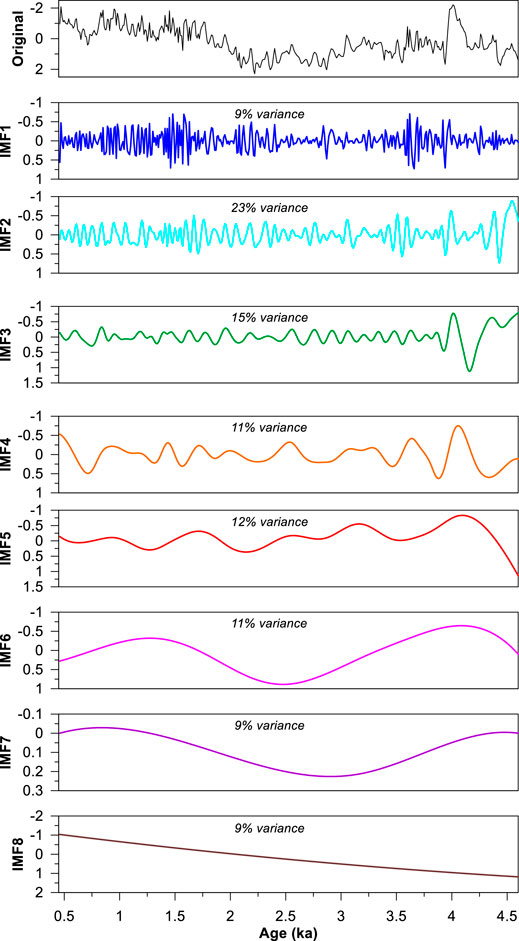- 1Qingdao Institute of Marine Geology, Qingdao, China
- 2Laboratory for Marine Mineral Resources, Pilot National Laboratory for Marine Science and Technology, Qingdao, China
- 3Wuhan Geological Survey Center, Wuhan, China
- 4Institute of Marine Science and Technology, Shandong University, Qingdao, China
- 5State Key Laboratory of Loess and Quaternary Geology, Institute of Earth Environment, Chinese Academy of Sciences, Xi’an, China
- 6Center for Excellence in Quaternary Science and Global Change, Chinese Academy of Sciences, Xi’an, China
- 7State Key Laboratory of Marine Resource Utilization in South China Sea, Hainan University, Haikou, China
- 8State Key Laboratory of Marine Geology, Tongji University, Shanghai, China
The North Pacific subtropical gyre (NPSTG) redistributes heat and moisture between low and high latitudes and plays a key role in modulating the global climate change and ecosystem. Recent evidence suggests intensification and poleward shift of the subtropical gyres over the last decades due to global warming, but insufficient observations have hampered insight into the integrated effects of ocean-atmosphere interactions at longer timescales. Here we present the first high-resolution (∼12 years) grain-size record from Core CF1 in the Okinawa Trough, western subtropical North Pacific, to reconstruct the evolution of the western boundary Kuroshio Current (KC) of NPSTG during the Late Holocene. Our results indicate the KC slow-down during 4.6–2.0 ka, followed by quick enhancement after 2.0 ka, with centennial-scale variabilities (500–700 years) superimposed on the long-term trend. Over millennial timescales, gradually increased pole-to-equator thermal gradient, due to orbital forcing mechanisms, resulted in long-term enhanced KC, whereas solar activity triggered phase changes in the tropical Pacific mean state and controlled KC anomalies on centennial timescales. We suggest that both forcing mechanisms resulted in ocean-atmosphere feedback provoking concurrent changes in mid-latitude westerly and subtropical easterly winds over the North Pacific, alternating their dominance as source regions causing the dynamic changes of KC at different timescales. Our findings offer insight into the role of external forcing mechanisms in the NPSTG changes before the Anthropocene, which have profound implications for the deeper understanding of changes in ocean gyres under global warming scenarios.
Introduction
As one of strong wind-driven western boundary currents (WBCs) of the North Pacific Subtropical Gyre (NPSTG), the Kuroshio Current (KC) originates from the northward branch of the North Equatorial Current (NEC), enters the Okinawa Trough off northeastern Taiwan, and then flows along the continental slope of East China Sea (ECS) before turning eastward through the Tokara Strait (Figure 1). The KC transports substantial amounts of heat and moisture poleward and thus plays an essential role in global climate change and heat balance (Hu et al., 2015). Despite recent progress in understanding the seasonal and interannual variabilities of the KC, which are generally related to El-Niño–Southern Oscillation (ENSO), Pacific Decadal Oscillation (PDO), and East Asian monsoon systems, there is ongoing debate concerning the KC dynamics over longer time scales (Nakamura, 2020). For ENSO, during La Niña events, the zonal sea surface temperature (SST) gradient across the equatorial Pacific Ocean enhances, strengthening the Walker Circulation with the easterly wind prevails, and the NEC bifurcation latitude (NBL) occurs at its southernmost position, the transported volumes of the KC increases; and the opposite occurs during El Niño events (Hu et al., 2015). Previous studies demonstrated that the variability of the KC along the margin of the East China Sea at interdecadal scales is more closely with PDO than with ENSO, and the KC generally decelerated during negative PDO with enhanced trade winds and weakened westerlies, and vice versa (Andres et al., 2009; Wu, 2013; Wu et al., 2019). Recently, the potential effects of global warming on the KC and other WBCs have raised significant concerns, suggesting that a stronger warming trend occurred over the KC during the past century, possibly associated with a synchronous poleward shift and/or intensification of WBCs (Wu et al., 2012; England et al., 2014; Hu et al., 2015; Yang et al., 2016; Yang et al., 2020). Reconstruction of the response of KC intensity to different forcing mechanisms at longer timescales will thus aid in better quantifying future changes in the WBCs.
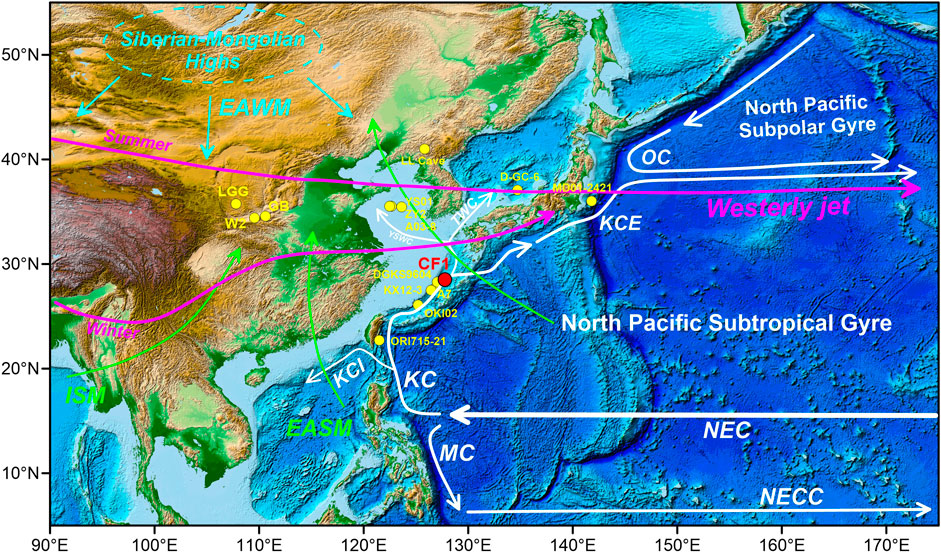
FIGURE 1. Location of Core CF1 and referenced sites with surface oceanic circulation and climatic systems over Asia and the western Pacific. EAWM, East Asian Winter Monsoon; EASM, East Asian summer Monsoon; ISM, Indian summer Monsoon. NEC, North Equatorial Current; NECC, North Equatorial Counter Current, KC, Kuroshio Current; TWC, Tsushima Warm Current; YSWC, Yellow Sea Warm Current; KCE, Kuroshio Current Extension; KCI, Kuroshio Current Intrusion; OC, Oyashio Current.
Sedimentary records from the Okinawa Trough, under the influence of the KC, are ideally located to reveal the oceanic-atmospheric dynamic influences that originated in both the tropical and high latitudes of North Pacific (Jian et al., 2000; Zheng et al., 2014; Zheng et al., 2016; Lim et al., 2017; Jiang et al., 2019; Li et al., 2019; Li et al., 2020). Although many studies have illustrated changes in the KC intensity and its flow path since the last glacial maximum (LGM), the different forcing mechanisms driving these changes are still debated. Specifically, most available records are adequate for characterizing long-term trends of the KC, e.g., the Holocene, but do not capture the short-term climate oscillations, largely due to the scarcity of robust proxy and/or low resolution of climate archives (Yamazaki et al., 2016). Here, we present a well-dated and high-resolution grain-size record from the middle Okinawa Trough that documents the evolution of the KC intensity during the last 4.6 kyr. The aim of this study is to characterize the long-term trend and centennial periodicity of the KC during the Late Holocene and to discuss the forcing mechanisms that caused them.
Materials and Methods
Sediment Core and Chronology
Gravity Core CF1 (water depth 1,180 m; 127.43°E, 28.42°N) (Figure 1), with a length of 351 cm, was retrieved from the western slope of the middle Okinawa Trough during a cruise in 2012. The core was sliced into 1-cm-thick subsamples after the cruise. The lithology of Core CF1 consists of homogeneous gray silty clay. No obvious depositional hiatus or turbidite layers were found within Core CF1. The planktonic foraminiferal species Neogloboquadrina dutertrei from the >150 μm size fraction of eight layers were picked up for accelerator mass spectrometry radiocarbon (AMS 14C) dating at Beta Analytic Inc.(Florida, United States) (Figure 2).
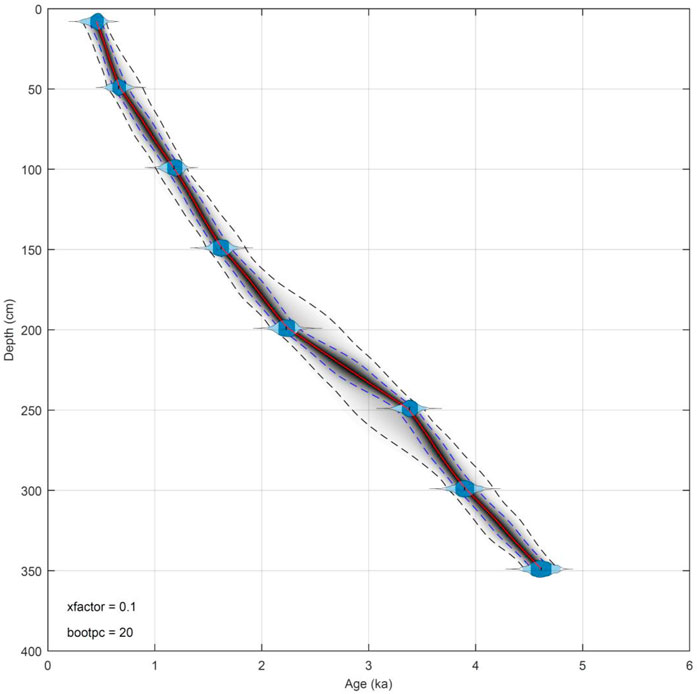
FIGURE 2. Age model of Core CF1 using the recently published age-depth modeling routine “Undatable” (Lougheed and Obrochta, 2019). Age error estimates of nonnormally 68 and 95% percentiles are also shown.
Considering the top segment of Core CF1 was damaged and lost during the sampling process, the age model of Core CF1 between 8 and 348 cm (Figure 2A) was constructed using the recently published age-depth modeling routine “Undatable” (Lougheed and Obrochta, 2019). The deterministic routines of Undatable, with a positive sedimentation rate prior and bootstrapping, result in median and mean age-depth models with age error estimates of non-normally 68% and 95% percentiles (Lougheed and Obrochta, 2019). Here, the AMS 14C ages were calibrated to a calendar age before 1950 CE (cal BP) using the Marine20 calibration curve (Heaton et al., 2020) and the ΔR value of 29 ± 18 a (Table 1). Default values for bootstrapping percentage and sedimentation rate uncertainty were set to 20% and 0.1 cm yr−1, respectively. The sedimentation rate of Core CF1 varied from 45 cm/kyr to 190 cm/kyr, with an average value of ∼90 cm/kyr.
2.2 Grain Size Analysis
Grain-size analysis was conducted using a Mastersizer-2000 laser particle-size analyzer at Qingdao Institute of Marine Geology, China Geological Survey, with a measurement range of 0.02–2,000 μm and a size resolution of 0.01ϕ. The measuring error was within 3%. Before the grain-size analyses, the samples were pretreated with 10% H2O2 and 0.5 mol/L HCl for 24 h to remove organic matter and biogenic carbonate, respectively. The high-resolution analysis provided a resolution of ∼12 years on average, with a lower resolution of ∼22 years for the interval between 2,400 and 3,460 years BP.
Varimax-Rotated Principal Component Analysis
Varimax-rotated Principal Component Analysis (V-PCA) is a statistical procedure that uses orthogonal transformation to convert a set of possibly correlated variables into a set of linearly uncorrelated variables called principal components. This method allowed us to separate out orthogonal modesand independent grain-size spectra from the grain size matrix that are related to potential input functions and sensitive to specific transport mechanisms (Darby et al., 2009; Hu et al., 2012; Yi et al., 2012; Zheng et al., 2014; Zheng et al., 2016). It has been used to successfully identify the transport mechanisms of the Yellow Sea (Hu et al., 2012) and the Okinawa Trough (Zheng et al., 2014; Zheng et al., 2016). In this study, V-PCA was applied to temporal variation of Core CF1 grain size spectrum with the input grain size matrix ranging from 0.41 to 707 μm. The mode of each extracted grain size component is defined as the grain size sets with largest factor loading, which is most representative for the grain size spectra (Figure 3).
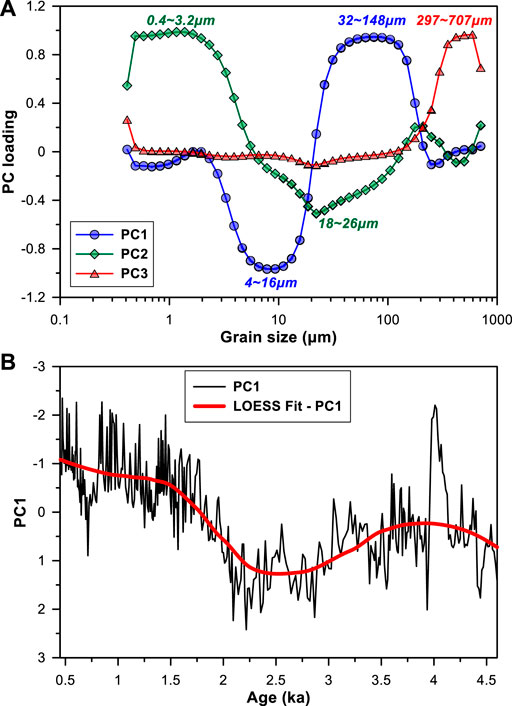
FIGURE 3. (A) PC1, PC2 and PC3 represent the components of V-PCA procedures and their variances are displayed. (B) Temporal variation of PC1 loading which is interpreted as an indicator of the KC (See discussion in Chapter 3.1).
Ensemble Empirical Mode Decomposition
The ensemble empirical mode decomposition (EEMD) method is based on the noise-assisted data analysis, which takes the average value of multiple measurements and obtains the ensemble means of corresponding intrinsic model functions (IMFs) as the results (Wu and Huang, 2009). EEMD is implemented through a sifting process that uses only local extrema. A complete sifting process stops when the residue becomes a monotonic function from which no more IMFs can be extracted. The total number of IMFs of a data set is lose to log2N (N is the number of total data points). Detail process and explanation can be found in the MATLAB EEMD code program instructions (Wu and Huang, 2009). Before performing the EEMD, the PC1 loading of Core CF1 is linearly interpolated at a 10-years interval. Eight IMFs are generated from our data by the EEMD method and spectral analyses is applied to determine the periodicities and periodic stabilities using the PAST software (details can be found in https://palaeo-electronica.org) (Figure 4). We aim to quantify the relative contributions of both the long-term trend and centennial-scale oscillations. Considering the sample resolution used in this study, the IMF1 and IMF2 components with periodicity less than 100 years are thus considered as decadal-scale noise (Figure 5A). At the same time, the IMF3, IMF4, and IMF5 components exhibit centennial-scale cyclic oscillations with a total variance of 39% (Figure 5B), while the IMF6, IMF7, and IMF8 components are regarded as millennial variability or long-term trend, contributing altogether 29% to the total variance (Figure 5C).
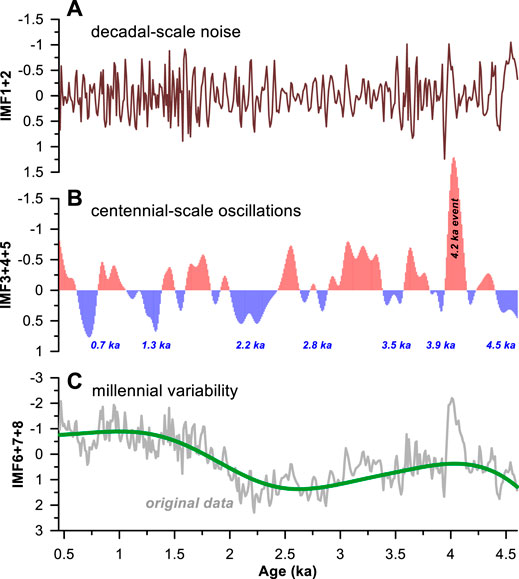
FIGURE 5. (A) Decadal-scale noise (IMF1 + 2), (B) Centennial-scale cyclic oscillations (IMF3 + 4 + 5), and (C) Millennial variability or long-term trend (IMF6 + 7 + 8) of KC intensity.
Results and Discussion
Paleoenvironment Implications of End-Members
Previous studies suggested the Okinawa Trough has multiple potential terrigenous sediment sources, mainly including the large rivers in China (Yellow and Yangtze Rivers) and small mountain rivers in Taiwan and Kyushu Islands, all of which display large temporal-spatial variations influenced by sea-level fluctuations, oceanic circulations, and East Asian monsoons over the last glacial-interglacial cycles (Dou et al., 2010; Dou et al., 2012; Wang et al., 2015; Dou et al., 2016; Beny et al., 2018; Li et al., 2019; Xu et al., 2019; Hu et al., 2020). Based on the results of previous studies, the sediment source-to-sink process in the ECS-Okinawa Trough since the LGM can be broadly summarized as follows: During the glacial periods marked by the low sea level (e.g., about 135 m below the present sea level during the LGM), the paleo-channels of Yellow and Yangtze Rivers were located on the YS and ECS shelves and may have directly entered the northern and middle regions of the Okinawa Trough, respectively. In contrast, Taiwan-derived sediments are confined to the southern region of the Okinawa Trough due to the weak or even absent KC during the glacial periods. Subsequently, sea level gradually rose from -135 m to -40 m during the deglaciation period (22–10 ka), resulting in the YS and ECS shelves being flooded by seawater along with the paleo-mouths of Yellow and Yangtze River which retreated quickly towards the YS shelf. During the process of sea level rise, terrigenous sediment supply became trapped on the shelf, although more intense continental erosion occurred resulting from the strengthened East Asian Summer Monsoon (EASM). Meanwhile, deglaciation transgression caused some reworked materials to be released from the ECS shelf into the Okinawa Trough, forming a broad tidal sand ridge covering the ECS middle-outer shelf. Conversely, the mainstream of the KC gradually deflected to the west of the Ryukyu Islands due to the rapid sea-level rise and then delivered the Taiwan Rivers sediment northward during this period. Provenance proxies indicated a significant change from a dominance of the paleo-Yangtze or paleo-Yellow River to an increased influence from Taiwanese rivers after 9–10 ka or ∼7 ka, associated with the establishment of a “water barrier” of strong KC intensity and a modern circulation pattern since then. Combining the results of previous studies, it can be found that the sea level has stabilized or changed very little and the ocean circulation system of ECS has been formed since the Late Holocene. At that time, the sediment transport dynamics affecting the middle Okinawa Trough are mainly controlled by changes in the strength of the KC.
For Core CF1, results of the V-PCA analyses on the grain-size matrix are shown in Figure 2A. Three principal grain-size components (PC1: 69%, PC2: 16%, and PC3: 10%) were identified for Core CF1, which totally account for 95% of the variance. The first mode (PC1) has a broad negative peak at 4–16 μm and a positive peak at 32–148 μm (Figure 2A). The second mode (PC2) has a positive peak at 0.4–3.2 μm and a trough around 18–26 μm (Figure 2A). The third mode (PC3) has a strongly positive peak at 297–707 μm (Figure 2A). Two nearby cores A7 and OKI02 gave the same modes with a consistent grain size structure, and such consistency strongly indicates that there must be identifiable mechanisms to account for these specific modes (Zheng et al., 2014; Zheng et al., 2016). As suggested by Zheng et al. (2014, 2016), three PCs of the Okinawa Trough cores (A7 and OKI02) were interpreted as KC silt (PC1), bottom nepheloid clay (PC2), and turbidity sand (PC3), respectively. Sr-Nd isotopic compositions of 5–18 μm fractions from Core AF2/OF3 were further compared with the potential endmembers (the Yangtze River, Yellow River, and rivers of Taiwan Island) to assess the provenance, which clearly indicated that the 5–18 μm fractions originated from rivers of Taiwan Island and are transported by, and sensitive to, the strength of the KC (Zheng et al., 2016). Specially, sea level has stabilized or changed very little and the ocean circulation system of ECS has been formed since the Middle Holocene, and at that time, the sediment transport dynamics affecting the middle Okinawa Trough are mainly controlled by changes in the strength of the KC (Zheng et al., 2014; Zheng et al., 2016). These lines of evidence support the interpretation of PC1 loading of Core CF1 as a dynamic proxy for the KC intensity.
Long-Term Trend of Kuroshio Current During the Late Holocene and Potential Influences Mechanisms
To quantify the relative contributions of long-term trend and centennial-scale oscillations of the KC, we performed a noise-assisted data analysis EEMD on the PC1 loading of Core CF1 after linearly interpolated at a 10-years interval. Based on the results of the EEMD, we combined the IMF6, IMF7 and IMF8 components (IMF6+7 + 8) to reveal the millennial variability or long-term trend of KC intensity (Figure 6A). Our reconstruction of the KC intensity contradicts recent inferences based on low-resolution magnetic parameters and paired organic paleothermometers (Li et al., 2019; Li et al., 2020), but is consistent with several other lines of evidence. For example, abundance of P. obliquiloculatata (Jian et al., 2000; Lin et al., 2006; Xiang et al., 2007), sediment mercury (Hg) enrichment factor (Lim et al., 2017), and sediment provenance changes (Jiang et al., 2019; Xu et al., 2019), as well as SST variations in the South Yellow Sea (Wang et al., 2011; Jia et al., 2019) (Figure 6B). Within the age uncertainty estimates, our IMF6+7 + 8 record of Core CF1 is broadly consistent with the abovementioned proxy evidence and suggests a slow-down of the KC during the period of 4.6–2.0 ka, followed by quickly enhanced KC and attaining the highest level at approximately 0.5 ka (Figure 6A). Additionally, climate records from the Taiwan Island (Selvaraj et al., 2007; Wang et al., 2015; Ding et al., 2020), Cheju Island (Park et al., 2016; Park, 2017) and Northeastern Asia (Hong et al., 2005; Zhao et al., 2021) reflect gradual precession-driven cooling/drying since the Early-Middle Holocene with rapid climate amelioration since ∼2.0 ka. Their similarity to the KC intensity evolution suggests the KC transports huge amounts of latent heat and water vapor to the atmosphere along its path and plays an important role in modulating surrounding climate change.
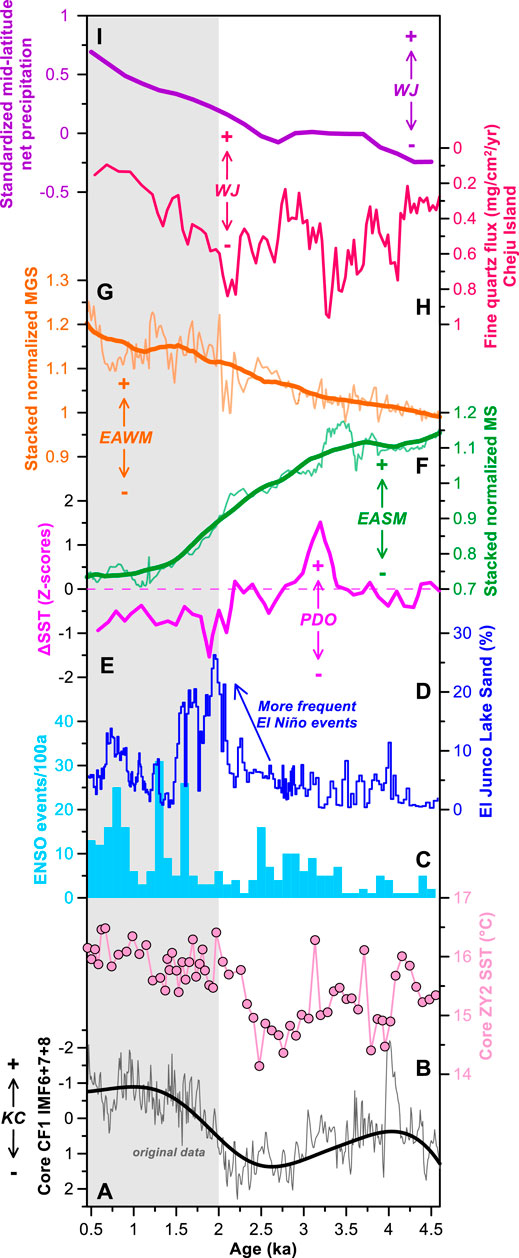
FIGURE 6. Temporal variations of paleorecords. (A) The long-term trend of KC intensity (IMF6 + 7 + 8) (this study, gray line is the original data). (B) SST of Core ZY2 (Wang et al., 2011). (C) ESNO events per 100-years (Moy et al., 2002). (D) Sand (%) of El Junco Lake (Conroy et al., 2008). (E) PDO-like variability (Chen et al., 2021). (F,G) Stacked normalized magnetic susceptibility (MS) and mean grain size (MGS) for EASM and EAWM, respectively, (Kang et al., 2020). (H) Fine quartz flux deposited at Cheju Island (Lim and Matsumoto, 2006, 2008). (I) Standardized, average mid-latitude (30°N–50°N) net precipitation (Routson et al., 2019).
What, then, explains Late Holocene KC evolution? Firstly, although a few uncertainties remain with respect to the Holocene ENSO activities, most of the records support a strong relationship between ENSO variability and the Equatorial Pacific mean state and suggests more frequent El Niño events during the Late Holocene (Figures 6C,D) (Moy et al., 2002; Conroy et al., 2008; Koutavas and Joanides, 2012; Sadekov et al., 2013; Gill et al., 2016; Barr et al., 2019). Enhanced El Niño activities during the Late Holocene, characterized by weakened Walker circulation and northernmost position of NEC bifurcation latitude, is not conducive to KC reinforcement at that time.
Secondly, the variability of the KC along the ECS margin at interdecadal scales is more closely related to PDO than to ENSO, and KC generally decelerated during the negative PDO phase, and vice versa (Andres et al., 2009; Wu, 2013; Wu et al., 2019). Recent study shows that PDO-like pattern shifts from a positive to a negative phase at ∼2 ka based on ΔSSTE-W between Cores MD01-2,412 and ODP1019C (Figure 6E) (Chen et al., 2021). Similar results are also found in the PDO record from the Santa Barbara Basin over the last 2,700 years (Beaufort and Grelaud, 2017). Commonly, negative PDO phase since ∼2 ka, characterized by decreased negative wind stress curl (WSC), should decelerate the southward Sverdrup flow in the subtropical gyre and thus weaken return flow (i.e., KC), which conflicts with the KC records from the Okinawa Trough.
Finally, the East Asian monsoon systems, including the southeasterly EASM and the northwesterly East Asian Winter Monsoon (EAWM), are another important factor influencing the variation of KC intensity (Jian et al., 2000; Zheng et al., 2016). High-resolution reconstruction of EASM and EAWM from three loess sections in the Loess Plateau display continuously weakened EASM (Figure 6F) and persistently strengthened EAWM during the Late Holocene (Figure 6G) (Kang et al., 2020). These situations would trigger less negative or even positive WSC over the North Pacific subtropics, suppressing the KC intensity, which also contradicts the enhanced KC since ∼2.0 ka.
Overall, low-latitude processes (e.g., East Asian monsoons and/or changes in ENSO/PDO-like phases) should be a secondary factor or negligible for the long-term trend of the KC intensity on millennial timescale during the Late Holocene.
Westerly Driven North Pacific Subtropical Gyre Variations During the Late Holocene
As discussed earlier, forcings other than low-latitude processes are required to explain the long-term trend of the KC intensity during the Late Holocene. Indeed, the KC is driven by a basin-scale negative WSC over the North Pacific, depending on the combined effects of subtropical easterly and mid-latitude westerly winds (Seager and Simpson, 2016). Enhanced negative WSC over the North Pacific forces stronger southward Sverdrup flow in the inner ocean, which is compensated by strengthened northward flow of the KC at the western boundary (Seager and Simpson, 2016). Accordingly, we hypothesize that the mid-latitude Westerly Jet (WJ) and its associated WSC in the North Pacific play a dominant role in the long-term trend of KC intensity since the Late Holocene. Recent studies have highlighted teleconnections between North Pacific atmospheric and oceanic circulations over the glacial-interglacial cycles, with equatorward (poleward) and intensified (weaker) WJ during the glacial (interglacial) periods, coupling with the expansion and strengthening of circulation gyres during cold periods and vice versa (Gray et al., 2018; Gray et al., 2020; Abell et al., 2021).
Moreover, dust records from the Tarim Basin (Han et al., 2019), the Cheju Island (Lim and Matsumoto, 2006, 2008), and the Japan Sea (Nagashima et al., 2013) suggested strengthening and southward shift of WJ occurred during the Late Holocene (Figure 6H), which is further confirmed by Holocene spatiotemporal precipitation patterns (Figure 6I) and climate model simulations (Chen et al., 2019; Herzschuh et al., 2019; Routson et al., 2019; Zhou et al., 2020). The forcing mechanism may be that seasonal difference between the winter and summer insolation across the latitudes results in gradually increased pole-to-equator thermal gradient during the Late Holocene (Chen et al., 2019; Routson et al., 2019). Thus, we provide direct evidence for the predominance of accelerating and southward shift of mid-latitude WJ, rather than low-latitude processes, causing more negative WSC over the North Pacific and thus stronger KC since ∼2 ka.
Solar Forcing of Centennial-Scale Variability of Kuroshio Current
Superimposed on the long-term trend of the KC is significant centennial-scale variability, which displays a larger amplitude and a longer anomaly duration after ∼2.5 ka (Figure 5B). We found a periodicity of ∼1,800-years (at the 95% significance level), ∼700-years (at the 90% significance level) and ∼500-years (at the 95% significance level) of the original PC1 record from Core CF1 by the PAST software (Figure 7). However, it seems inappropriate to determine the 1,800-years cycle as one of the credible climate oscillations due to their insufficient temporal length of the original PC1 records. We therefore consider only the 500–700-year cycles because of underlying solar forcing. Moreover, we also performed wavelet power spectrum analyses on the IMF3+4 + 5 record and reflected statistically significant centennial periodicities on approximately 500-years and 700-years (>90% confidence level) (Figure 8). Similar periodicities are also found in the solar activity records and exhibit strong power after ∼2.5 ka (Wanner et al., 2008; Steinhilber et al., 2012). This further suggests a link between the KC variability and solar activity on a centennial-scale, with reduced solar activity corresponding with weak KC intensity (Figure 9). Not all KC weakening events covary with sunspot number (SN) on a centennial-scale for the Late Holocene, which may stem from age model uncertainties and sampling resolution.
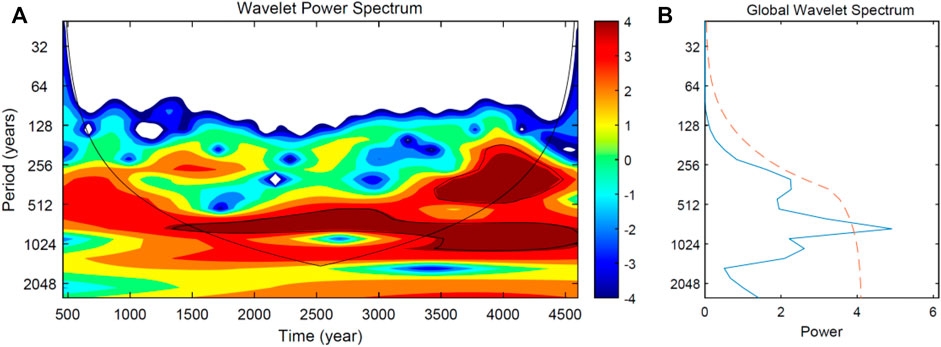
FIGURE 8. (A) The wavelet power spectra and (B) global wavelet spectrum for IMF3 + 4 + 5 record was obtained after interpolation to evenly spaced data (10a) The shape of the mother wavelet was set to Morlet. High (low) power is indicated by red (blue) color. The confidence level at 95% is depicted with black lines, and areas beyond the cone of influence are shaded.
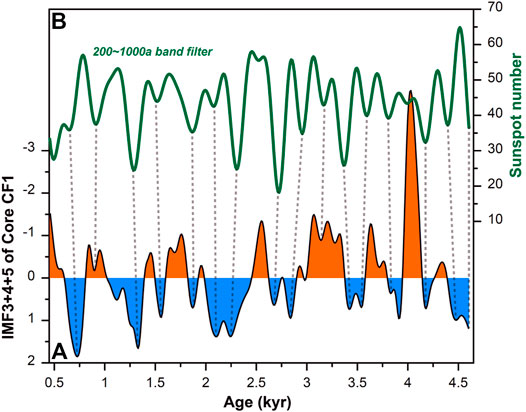
FIGURE 9. Comparison of the KC intensity with sunspot number. (A) The IMF3 + 4 + 5 record of Core CF1 representing the centennial-scale variations of KC. (B) Sunspot number as a solar activity proxy (200–1,000a Band-pass filter) (Wu et al., 2018).
Previous studies highlight that solar variability (500–700-year cycles), amplified by low-latitude oceanic-atmospheric interactions (e.g., ENSO), could have played an important role in regulating centennial-scales climate variations (Liu et al., 2014; Zhu et al., 2017; Xu et al., 2019; Xu et al., 2020). Model simulations suggest that the ENSO system acts as a mediator of solar activities on the climate system’s low-latitude heat engine (Emile-Geay et al., 2007). This has been further confirmed by paleoclimate reconstructions, which show that the tropical Pacific mean states shift in response to the solar activities of the last 1,500 years (Mann et al., 2009), for the early-middle Holocene (Marchitto et al., 2010), as well as the entire Holocene (Ersek et al., 2012). In addition, solar irradiance variations can also trigger changes in the strength and direction of WJ across the North Atlantic via a “top-down” mechanism (Ineson et al., 2011), with the southward migration and enhanced intensity of WJ responding to lower solar irradiance (Olsen et al., 2012; Wirth et al., 2013; Lan et al., 2020). Nonetheless, if some direct (though amplified) solar forcing of the WJ was the dominant control on the KC intensity, we would expect enhancement of KC intensity correlated with reduced solar activity, conflicting with the fact observed (Figure 3). Taken together, we can conclude that, since the Late Holocene, weak solar irradiation makes the tropical Pacific to be an El Niño-like state, associated with weakened easterly trade winds and attenuated EASM, which overwhelms the enhanced intensity of mid-latitude WJ and contributes to the decreased KC intensity on centennial-scale.
Summary
New 1-cm contiguous grain size data from Core CF1 provide new insights into Late Holocene millennial-to centennial-scale KC variability. We interpret the long-term trend of the KC as a response to the strengthening and southward shift of WJ during the Late Holocene, resulting from gradual enhanced pole-to-equator thermal gradient forced by orbital forcing mechanisms. However, the waxing and waning of solar activities, via changes in Walker circulation and ENSO of the tropical Pacific, have an overwhelming influence on the centennial-scale changes of the KC intensity. Our findings thus, highlight those two regions, the high-mid latitude and tropical Pacific, alternate their dominance as source regions causing the dynamic changes of the KC at different timescales.
Recent evidence suggests that the WBCs have strengthened and shifted toward the poles due to global warming during the past few decades, which is consistent with the centennial-scale changes of KC intensity forced by solar activity. However, if global warming continues, especially with the Arctic amplification, we hypothesize that the WBCs may be in turn decrease once the threshold is breached, as shown by the long-term trend of KC during the Late Holocene. Further comprehensive climate model research is necessary to understand how the KC responds to different forcing mechanisms under a continuous global warming scenario, which is crucial to the reliable prediction of the future climate changes in East Asia.
Data Availability Statement
The raw data supporting the conclusion of this article will be made available by the authors, without undue reservation.
Author Contributions
BH and JL designed the project and developed the conceptual framework. XD collected the AMS 14C dating materials and wrote the manuscript. JZ and QL analyzed sediment grain size. YY performed the EEMD analysis. JL, XZ, and LY were involved in the interpretation of the results.
Funding
This research was jointly supported by the National Natural Science Foundation of China (No. 41976192), the Strategic Priority Research Program of Chinese Academy of Sciences (No. XDB40000000), the National Key Research and Development Program of China (No. 2018YFC0310001), Shandong Province Natural Science Foundation (No. ZR202103010094), the Project of China Geological Survey (No. DD20191010).
Conflict of Interest
The authors declare that the research was conducted in the absence of any commercial or financial relationships that could be construed as a potential conflict of interest.
Publisher’s Note
All claims expressed in this article are solely those of the authors and do not necessarily represent those of their affiliated organizations, or those of the publisher, the editors and the reviewers. Any product that may be evaluated in this article, or claim that may be made by its manufacturer, is not guaranteed or endorsed by the publisher.
References
Abell, J. T., Winckler, G., Anderson, R. F., and Herbert, T. D. (2021). Poleward and Weakened Westerlies during Pliocene Warmth. Nature 589 (7840), 70–75. doi:10.1038/s41586-020-03062-1
Andres, M., Park, J.-H., Wimbush, M., Zhu, X.-H., Nakamura, H., Kim, K., et al. (2009). Manifestation of the Pacific Decadal Oscillation in the Kuroshio. Geophys. Res. Lett. 36, L16602. doi:10.1029/2009gl039216
Barr, C., Tibby, J., Leng, M. J., Tyler, J. J., Henderson, A. C. G., Overpeck, J. T., et al. (2019). Holocene El Nino-Southern Oscillation Variability Reflected in Subtropical Australian Precipitation. Scientific Rep. 9 (1), 1627. doi:10.1038/s41598-019-38626-3
Beaufort, L., and Grelaud, M. (2017). A 2700-year Record of ENSO and PDO Variability from the Californian Margin Based on Coccolithophore Assemblages and Calcification. Prog. Earth Planet. Sci. 4 (1), 5. doi:10.1186/s40645-017-0123-z
Beny, F., Toucanne, S., Skonieczny, C., Bayon, G., and Ziegler, M. (2018). Geochemical Provenance of Sediments from the Northern East China Sea Document a Gradual Migration of the Asian Monsoon belt over the Past 400,000 Years. Quat. Sci. Rev. 190, 161–175. doi:10.1016/j.quascirev.2018.04.032
Chen, F., Chen, J., Huang, W., Chen, S., Huang, X., Jin, L., et al. (2019). Westerlies Asia and Monsoonal Asia: Spatiotemporal Differences in Climate Change and Possible Mechanisms on Decadal to Sub-orbital Timescales. Earth-Sci. Rev. 192, 337–354. doi:10.1016/j.earscirev.2019.03.005
Chen, C., Zhao, W., and Zhang, X. (2021). Pacific Decadal Oscillation-like Variability at a Millennial Timescale during the Holocene. Glob. Planet. Change 199, 103448. doi:10.1016/j.gloplacha.2021.103448
Conroy, J. L., Overpeck, J. T., Cole, J. E., Shanahan, T. M., and Steinitz-Kannan, M. (2008). Holocene Changes in Eastern Tropical Pacific Climate Inferred from a Galápagos lake Sediment Record. Quat. Sci. Rev. 27 (11-12), 1166–1180. doi:10.1016/j.quascirev.2008.02.015
Darby, D. A., Ortiz, J., Polyak, L., Lund, S., Jakobsson, M., and Woodgate, R. A. (2009). The Role of Currents and Sea Ice in Both Slowly Deposited central Arctic and Rapidly Deposited Chukchi–Alaskan Margin Sediments. Glob. Planet. Change 68 (1-2), 58–72. doi:10.1016/j.gloplacha.2009.02.007
Xu, D., Lu, H., Chu, G., Liu, L., Shen, C., Li, F., et al. (2019). Synchronous 500-year Oscillations of Monsoon Climate and Human Activity in Northeast Asia. Nat. Commun. 10, 4105. doi:10.1038/s41467-019-12138-0
Ding, X., Zheng, L., Zheng, X., and Kao, S.-J. (2020). Holocene East Asian Summer Monsoon Rainfall Variability in Taiwan. Front. Earth Sci. 8, 234. doi:10.3389/feart.2020.00234
Dou, Y., Yang, S., Liu, Z., Clift, P. D., Shi, X., Yu, H., et al. (2010). Provenance Discrimination of Siliciclastic Sediments in the Middle Okinawa Trough since 30ka: Constraints from Rare Earth Element Compositions. Mar. Geol. 275 (1-4), 212–220. doi:10.1016/j.margeo.2010.06.002
Dou, Y., Yang, S., Liu, Z., Shi, X., Li, J., Yu, H., et al. (2012). Sr–Nd Isotopic Constraints on Terrigenous Sediment Provenances and Kuroshio Current Variability in the Okinawa Trough during the Late Quaternary. Palaeogeography, Palaeoclimatology. Palaeoecology 365-366, 38–47. doi:10.1016/j.palaeo.2012.09.003
Dou, Y., Yang, S., Shi, X., Clift, P. D., Liu, S., Liu, J., et al. (2016). Provenance Weathering and Erosion Records in Southern Okinawa Trough Sediments since 28ka: Geochemical and Sr–Nd–Pb Isotopic Evidences. Chem. Geology. 425, 93–109. doi:10.1016/j.chemgeo.2016.01.029
Emile-Geay, J., Cane, M., Seager, R., Kaplan, A., and Almasi, P. (2007). El Niño as a Mediator of the Solar Influence on Climate. Paleoceanography 22, PA3210. doi:10.1029/2006PA001304
England, M. H., McGregor, S., Spence, P., Meehl, G. A., Timmermann, A., Cai, W., et al. (2014). Recent Intensification of Wind-Driven Circulation in the Pacific and the Ongoing Warming Hiatus. Nat. Clim. Change 4 (3), 222–227. doi:10.1038/nclimate2106
Ersek, V., Clark, P. U., Mix, A. C., Cheng, H., and Lawrence Edwards, R. (2012). Holocene winter Climate Variability in Mid-Latitude Western North America. Nat. Commun. 3 (1), 1219. doi:10.1038/ncomms2222
Gill, E. C., Rajagopalan, B., Molnar, P., and Marchitto, T. M. (2016). Reduced-dimension Reconstruction of the Equatorial Pacific SST and Zonal Wind fields over the Past 10,000 Years Using Mg/Ca and Alkenone Records. Paleoceanography 31 (7), 928–952. doi:10.1002/2016PA002948
Gray, W. R., Rae, J. W. B., Wills, R. C. J., Shevenell, A. E., Taylor, B., Burke, A., et al. (2018). Deglacial Upwelling, Productivity and CO2 Outgassing in the North Pacific Ocean. Nat. Geosci. 11 (5), 340–344. doi:10.1038/s41561-018-0108-6
Gray, W. R., Wills, R. C. J., Rae, J. W. B., Burke, A., Ivanovic, R. F., Roberts, W. H. G., et al. (2020). Wind-Driven Evolution of the North Pacific Subpolar Gyre over the Last Deglaciation. Geophys. Res. Lett. 47, e2019GL086328. doi:10.1029/2019gl086328
Han, W., Lü, S., Appel, E., Berger, A., Madsen, D., Vandenberghe, J., et al. (2019). Dust Storm Outbreak in Central Asia after ∼3.5 Kyr BP. Geophys. Res. Lett. 46 (13), 7624–7633. doi:10.1029/2018GL081795
Heaton, T. J., Köhler, P., Butzin, M., Bard, E., Reimer, R. W., Austin, W. E. N., et al. (2020). Marine20—The Marine Radiocarbon Age Calibration Curve (0–55,000 Cal BP). Radiocarbon 62 (4), 779–820. doi:10.1017/rdc.2020.68
Herzschuh, U., Cao, X., Laepple, T., Dallmeyer, A., Telford, R. J., Ni, J., et al. (2019). Position and Orientation of the westerly Jet Determined Holocene Rainfall Patterns in China. Nat. Commun. 10 (1), 2376. doi:10.1038/s41467-019-09866-8
Hong, Y. T., Hong, B., Lin, Q. H., Shibata, Y., Hirota, M., Zhu, Y. X., et al. (2005). Inverse Phase Oscillations between the East Asian and Indian Ocean Summer Monsoons during the Last 12000 Years and Paleo-El Niño. Earth Planet. Sci. Lett. 231 (3), 337–346. doi:10.1016/j.epsl.2004.12.025
Hu, B., Yang, Z., Zhao, M., Saito, Y., Fan, D., and Wang, L. (2012). Grain Size Records Reveal Variability of the East Asian Winter Monsoon since the Middle Holocene in the Central Yellow Sea Mud Area, China. Sci. China Earth Sci. 55 (10), 1656–1668. doi:10.1007/s11430-012-4447-7
Hu, D., Wu, L., Cai, W., Gupta, A. S., Ganachaud, A., Qiu, B., et al. (2015). Pacific Western Boundary Currents and Their Roles in Climate. Nature 522 (7556), 299–308. doi:10.1038/nature14504
Hu, S., Zeng, Z., Fang, X., Yin, X., Chen, Z., Li, X., et al. (2020). Increasing Terrigenous Sediment Supply from Taiwan to the Southern Okinawa Trough over the Last 3000 Years Evidenced by Sr Nd Isotopes and Geochemistry. Sediment. Geol. 406, 105725. doi:10.1016/j.sedgeo.2020.105725
Ineson, S., Scaife, A. A., Knight, J. R., Manners, J. C., Dunstone, N. J., Gray, L. J., et al. (2011). Solar Forcing of winter Climate Variability in the Northern Hemisphere. Nat. Geosci. 4 (11), 753–757. doi:10.1038/ngeo1282
Jia, Y., Li, D.-W., Yu, M., Zhao, X., Xiang, R., Li, G., et al. (2019). High- and Low-Latitude Forcing on the South Yellow Sea Surface Water Temperature Variations during the Holocene. Glob. Planet. Change 182, 103025. doi:10.1016/j.gloplacha.2019.103025
Jian, Z., Wang, P., Saito, Y., Wang, J., P£aumann, U., Ob, T., et al. (2000). Holocene Variability of the Kuroshio Current in the Okinawa Trough, Northwestern Pacific Ocean. Earth Planet. Sci. Lett. 184, 305–319. doi:10.1016/s0012-821x(00)00321-6
Jiang, F., Xiong, Z., Frank, M., Yin, X., and Li, A. (2019). The Evolution and Control of Detrital Sediment Provenance in the Middle and Northern Okinawa Trough since the Last Deglaciation: Evidence from Sr and Nd Isotopes. Palaeogeography, Palaeoclimatology. Palaeoecology 522, 1–11. doi:10.1016/j.palaeo.2019.02.017
Wang, J., Li, A., Xu, K., Zheng, X., and Huang, J. (2015). Clay mineral and Grain Size Studies of Sediment Provenances and Paleoenvironment Evolution in the Middle Okinawa Trough since 17ka. Mar. Geol. 366, 49–61. doi:10.1016/j.margeo.2015.04.007
Kang, S., Du, J., Wang, N., Dong, J., Wang, D., Wang, X., et al. (2020). Early Holocene Weakening and Mid- to Late Holocene Strengthening of the East Asian winter Monsoon. Geology 48 (11), 1043–1047. doi:10.1130/g47621.1
Koutavas, A., and Joanides, S. (2012). El Niño-Southern Oscillation Extrema in the Holocene and Last Glacial Maximum. Paleoceanography 27, PA4208. doi:10.1029/2012pa002378
Lan, J., Zhang, J., Cheng, P., Ma, X., Ai, L., Chawchai, S., et al. (2020). Late Holocene Hydroclimatic Variation in central Asia and its Response to Mid-latitude Westerlies and Solar Irradiance. Quat. Sci. Rev. 238, 106330. doi:10.1016/j.quascirev.2020.106330
Li, Q., Zhang, Q., Li, G., Liu, Q., Chen, M.-T., Xu, J., et al. (2019). A New Perspective for the Sediment Provenance Evolution of the Middle Okinawa Trough since the Last Deglaciation Based on Integrated Methods. Earth Planet. Sci. Lett. 528, 115839. doi:10.1016/j.epsl.2019.115839
Li, Q., Li, G., Chen, M. T., Xu, J., Liu, S., and Chen, M. (2020). New Insights into Kuroshio Current Evolution since the Last Deglaciation Based on Paired Organic Paleothermometers from the Middle Okinawa Trough. Paleoceanogr. Paleoclimatol. 35, e2020PA004140. doi:10.1029/2020pa004140
Wang, L.-C., Behling, H., Kao, S.-J., Li, H.-C., Selvaraj, K., Hsieh, M.-L., et al. (2015). Late Holocene Environment of Subalpine Northeastern Taiwan from Pollen and Diatom Analysis of lake Sediments. J. Asian Earth Sci. 114, 447–456. doi:10.1016/j.jseaes.2015.03.037
Lim, J., and Matsumoto, E. (2006). Bimodal Grain-Size Distribution of Aeolian Quartz in a Maar of Cheju Island, Korea, during the Last 6500 years: Its Flux Variation and Controlling Factor. Geophys. Res. Lett. 33 (21). doi:10.1029/2006GL027432
Lim, J., and Matsumoto, E. (2008). Fine Aeolian Quartz Records in Cheju Island, Korea, during the Last 6500 Years and Pathway Change of the Westerlies over East Asia. J. Geophys. Res. Atmos. 113, D08106. doi:10.1029/2007JD008501
Lim, D., Kim, J., Xu, Z., Jeong, K., and Jung, H. (2017). New Evidence for Kuroshio Inflow and deepwater Circulation in the Okinawa Trough, East China Sea: Sedimentary Mercury Variations over the Last 20 Kyr. Paleoceanography 32 (6), 571–579. doi:10.1002/2017pa003116
Lin, Y.-S., Wei, K.-Y., Lin, I.-T., Yu, P.-S., Chiang, H.-W., Chen, C.-Y., et al. (2006). The Holocene Pulleniatina Minimum Event Revisited: Geochemical and Faunal Evidence from the Okinawa Trough and Upper Reaches of the Kuroshio Current. Mar. Micropaleontol. 59 (3-4), 153–170. doi:10.1016/j.marmicro.2006.02.003
Liu, Z., Lu, Z., Wen, X., Otto-Bliesner, B. L., Timmermann, A., and Cobb, K. M. (2014). Evolution and Forcing Mechanisms of El Nino over the Past 21,000 Years. Nature 515 (7528), 550–553. doi:10.1038/nature13963
Lougheed, B. C., and Obrochta, S. P. (2019). A Rapid, Deterministic Age-Depth Modeling Routine for Geological Sequences with Inherent Depth Uncertainty. Paleoceanogr. Paleoclimatol. 34 (1), 122–133. doi:10.1029/2018PA003457
Mann, M. E., Woodruff, J. D., Donnelly, J. P., and Zhang, Z. (2009). Atlantic Hurricanes and Climate Over the Past 1,500 Years. Nature 460 (7257), 880–883. doi:10.1038/nature08219
Marchitto, T. M., Muscheler, R., Ortiz Joseph, D., Carriquiry Jose, D., and van Geen, A. (2010). Dynamical Response of the Tropical Pacific Ocean to Solar Forcing during the Early Holocene. Science 330 (6009), 1378–1381. doi:10.1126/science.1194887
Moy, C. M., Seltzer, G. O., Rodbell, D. T., and Anderson, D. M. (2002). Variability of El Niño/Southern Oscillation Activity at Millennial Timescales during the Holocene Epoch. Nature 420 (6912), 162–165. doi:10.1038/nature01194
Nagashima, K., Tada, R., and Toyoda, S. (2013). Westerly Jet-East Asian Summer Monsoon Connection during the Holocene. Geochemistry, Geophysics. Geosystems 14 (12), 5041–5053. doi:10.1002/2013gc004931
Nakamura, H. (2020). “Changing Kuroshio and its Affected Shelf Sea: A Physical View,” in Changing Asia-Pacific Marginal Seas, 265–305. doi:10.1007/978-981-15-4886-4_15
Olsen, J., Anderson, N. J., and Knudsen, M. F. (2012). Variability of the North Atlantic Oscillation over the Past 5,200 Years. Nat. Geosci. 5 (11), 808–812. doi:10.1038/ngeo1589
Park, J., Shin, Y. H., and Byrne, R. (2016). Late-Holocene Vegetation and Climate Change in Jeju Island, Korea and its Implications for ENSO Influences. Quat. Sci. Rev. 153, 40–50. doi:10.1016/j.quascirev.2016.10.011
Park, J. (2017). Solar and Tropical Ocean Forcing of Late-Holocene Climate Change in Coastal East Asia. Palaeogeography, Palaeoclimatology. Palaeoecology 469, 74–83. doi:10.1016/j.palaeo.2017.01.005
Routson, C. C., McKay, N. P., Kaufman, D. S., Erb, M. P., Goosse, H., Shuman, B. N., et al. (2019). Mid-latitude Net Precipitation Decreased with Arctic Warming during the Holocene. Nature 568 (7750), 83–87. doi:10.1038/s41586-019-1060-3
Sadekov, A. Y., Ganeshram, R., Pichevin, L., Berdin, R., McClymont, E., Elderfield, H., et al. (2013). Palaeoclimate Reconstructions Reveal a strong Link between El Niño-Southern Oscillation and Tropical Pacific Mean State. Nat. Commun. 4 (1), 2692. doi:10.1038/ncomms3692
Seager, R., and Simpson, I. R. (2016). Western Boundary Currents and Climate Change. J. Geophys. Res. Oceans 121 (9), 7212–7214. doi:10.1002/2016JC012156
Selvaraj, K., Chen, C. T. A., and Lou, J.-Y. (2007). Holocene East Asian Monsoon Variability: Links to Solar and Tropical Pacific Forcing. Geophys. Res. Lett. 34 (1). doi:10.1029/2006gl028155
Steinhilber, F., Abreu, J. A., Beer, J., Brunner, I., Christl, M., Fischer, H., et al. (2012). 9,400 Years of Cosmic Radiation and Solar Activity from Ice Cores and Tree Rings. Proc. Natl. Acad. Sci. U. S. A. 109 (16), 5967–5971. doi:10.1073/pnas.1118965109
Wang, L., Yang, Z., Zhang, R., Fan, D., Zhao, M., and Hu, B. (2011). Sea Surface Temperature Records of Core ZY2 from the central Mud Area in the South Yellow Sea during Last 6200 Years and Related Effect of the Yellow Sea Warm Current. Chin. Sci. Bull. 56 (15), 1588–1595. doi:10.1007/s11434-011-4442-y
Wanner, H., Beer, J., Bütikofer, J., Crowley, T. J., Cubasch, U., Flückiger, J., et al. (2008). Mid- to Late Holocene Climate Change: an Overview. Quat. Sci. Rev. 27 (19), 1791–1828. doi:10.1016/j.quascirev.2008.06.013
Wirth, S. B., Glur, L., Gilli, A., and Anselmetti, F. S. (2013). Holocene Flood Frequency across the Central Alps – Solar Forcing and Evidence for Variations in North Atlantic Atmospheric Circulation. Quat. Sci. Rev. 80, 112–128. doi:10.1016/j.quascirev.2013.09.002
Wu, C. J., Usoskin, I. G., Krivova, N., Kovaltsov, G. A., Baroni, M., and Bard, E. (2018). Solar Activity Over Nine Millennia: A Consistent Multi-Proxy Reconstruction. Astronomy and Astrophysics 615, A93.
Wu, Z., and Huang, N. E. (2009). Ensemble Empirical Mode Decomposition: a Noiseassisted Data Analysis Method. Adv. Adapt. Data Anal. 1 (1), 1–41. doi:10.1142/S1793536909000047
Wu, L., Cai, W., Zhang, L., Nakamura, H., Timmermann, A., Joyce, T., et al. (2012). Enhanced Warming over the Global Subtropical Western Boundary Currents. Nat. Clim. Change 2 (3), 161–166. doi:10.1038/nclimate1353
Wu, C.-R., Wang, Y.-L., and Chao, S.-Y. (2019). Disassociation of the Kuroshio Current with the Pacific Decadal Oscillation since 1999. Remote Sens. 11 (3), 276. doi:10.3390/rs11030276
Wu, C.-R. (2013). Interannual Modulation of the Pacific Decadal Oscillation (PDO) on the Low-Latitude Western North Pacific. Prog. Oceanogr. 110, 49–58. doi:10.1016/j.pocean.2012.12.001
Xiang, R., Sun, Y., Li, T., Oppo, D. W., Chen, M., and Zheng, F. (2007). Paleoenvironmental Change in the Middle Okinawa Trough since the Last Deglaciation: Evidence from the Sedimentation Rate and Planktonic Foraminiferal Record. Palaeogeography, Palaeoclimatology. Palaeoecology 243 (3-4), 378–393. doi:10.1016/j.palaeo.2006.08.016
Xu, Z., Lim, D., Li, T., Kim, S., Jung, H., Wan, S., et al. (2019). REEs and Sr-Nd Isotope Variations in a 20 Ky-Sediment Core from the Middle Okinawa Trough, East China Sea: An In-Depth Provenance Analysis of Siliciclastic Components. Mar. Geology. 415, 105970. doi:10.1016/j.margeo.2019.105970
Xu, D., Lu, H., Chu, G., Shen, C., Li, F., Wu, J., et al. (2020). Asynchronous 500-year Summer Monsoon Rainfall Cycles between Northeast and Central China during the Holocene. Glob. Planet. Change 195, 103324. doi:10.1016/j.gloplacha.2020.103324
Yamazaki, A., Watanabe, T., Tsunogai, U., Iwase, F., and Yamano, H. (2016). A 150-year Variation of the Kuroshio Transport Inferred from Coral Nitrogen Isotope Signature. Paleoceanography 31 (6), 838–846. doi:10.1002/2015pa002880
Yang, H., Lohmann, G., Wei, W., Dima, M., Ionita, M., and Liu, J. (2016). Intensification and Poleward Shift of Subtropical Western Boundary Currents in a Warming Climate. J. Geophys. Res. Oceans 121 (7), 4928–4945. doi:10.1002/2015JC011513
Yang, H., Lohmann, G., Krebs-Kanzow, U., Ionita, M., Shi, X., Sidorenko, D., et al. (2020). Poleward Shift of the Major Ocean Gyres Detected in a Warming Climate. Geophys. Res. Lett. 47 (5), e2019GL085868. doi:10.1029/2019GL085868
Yi, L., Yu, H.-J., Ortiz, J. D., Xu, X.-Y., Chen, S.-L., Ge, J.-Y., et al. (2012). Late Quaternary Linkage of Sedimentary Records to Three Astronomical Rhythms and the Asian Monsoon, Inferred from a Coastal Borehole in the South Bohai Sea, China. Palaeogeography, Palaeoclimatology. Palaeoecology 329-330, 101–117. doi:10.1016/j.palaeo.2012.02.020
Zhao, J., Tan, L., Yang, Y., Pérez-Mejías, C., Brahim, Y. A., Lan, J., et al. (2021). New Insights towards an Integrated Understanding of NE Asian Monsoon during Mid to Late Holocene. Quat. Sci. Rev. 254, 106793. doi:10.1016/j.quascirev.2020.106793
Zheng, X., Li, A., Wan, S., Jiang, F., Kao, S. J., and Johnson, C. (2014). ITCZ and ENSO Pacing on East Asian winter Monsoon Variation during the Holocene: Sedimentological Evidence from the Okinawa Trough. J. Geophys. Res. Oceans 119 (7), 4410–4429. doi:10.1002/2013jc009603
Zheng, X., Li, A., Kao, S., Gong, X., Frank, M., Kuhn, G., et al. (2016). Synchronicity of Kuroshio Current and Climate System Variability since the Last Glacial Maximum. Earth Planet. Sci. Lett. 452, 247–257. doi:10.1016/j.epsl.2016.07.028
Zhou, P., Shi, Z., Li, X., and Zhou, W. (2020). Response of Westerly Jet over the Northern Hemisphere to Astronomical Insolation during the Holocene. Front. Earth Sci. 8, 282. doi:10.3389/feart.2020.00282
Keywords: Kuroshio Current, Okinawa Trough, solar forcing, ocean-atmosphere coupling, Late Holocene, westerly
Citation: Ding X, Hu B, Li J, Zhao J, Yao Y, Li Q, Lan J, Zheng X and Yi L (2022) Late Holocene Orbital Forcing and Solar Activity on the Kuroshio Current of Subtropical North Pacific at Different Timescales. Front. Earth Sci. 10:845228. doi: 10.3389/feart.2022.845228
Received: 29 December 2021; Accepted: 31 January 2022;
Published: 14 March 2022.
Edited by:
Xiting Liu, Ocean University of China, ChinaReviewed by:
Liang Dong, Shanghai Jiao Tong University, ChinaZhaokai Xu, Institute of Oceanology (CAS), China
Copyright © 2022 Ding, Hu, Li, Zhao, Yao, Li, Lan, Zheng and Yi. This is an open-access article distributed under the terms of the Creative Commons Attribution License (CC BY). The use, distribution or reproduction in other forums is permitted, provided the original author(s) and the copyright owner(s) are credited and that the original publication in this journal is cited, in accordance with accepted academic practice. No use, distribution or reproduction is permitted which does not comply with these terms.
*Correspondence: Bangqi Hu, YmFuZ3FpaHVAZ21haWwuY29t
 Xue Ding1,2
Xue Ding1,2 Bangqi Hu
Bangqi Hu Qing Li
Qing Li Jianghu Lan
Jianghu Lan Liang Yi
Liang Yi
